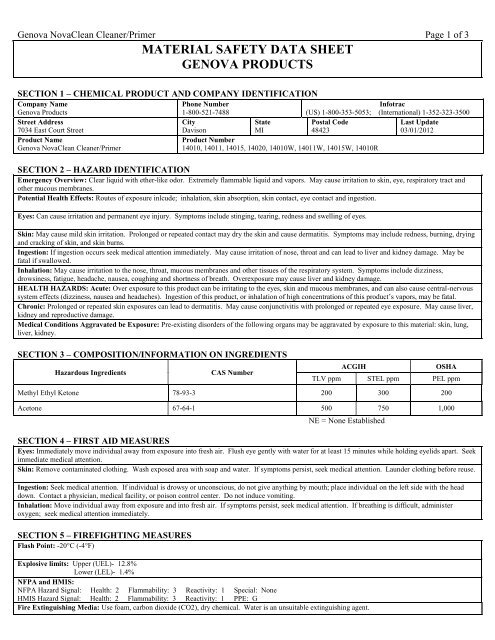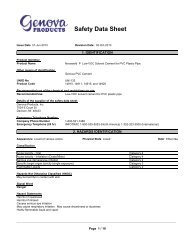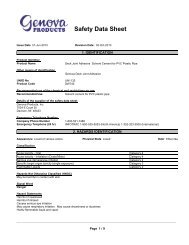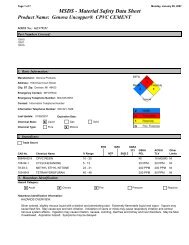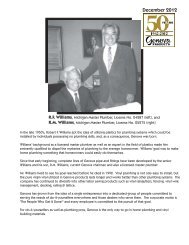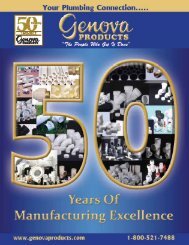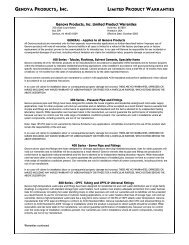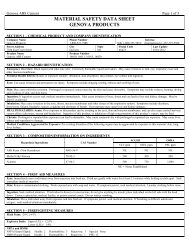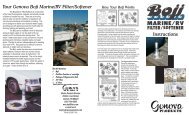NovaClean Cleaner/Primer - Genova Products
NovaClean Cleaner/Primer - Genova Products
NovaClean Cleaner/Primer - Genova Products
Create successful ePaper yourself
Turn your PDF publications into a flip-book with our unique Google optimized e-Paper software.
<strong>Genova</strong> <strong>NovaClean</strong> <strong>Cleaner</strong>/<strong>Primer</strong> Page 1 of 3<br />
MATERIAL SAFETY DATA SHEET<br />
GENOVA PRODUCTS<br />
SECTION 1 – CHEMICAL PRODUCT AND COMPANY IDENTIFICATION<br />
Company Name<br />
<strong>Genova</strong> <strong>Products</strong><br />
Street Address<br />
7034 East Court Street<br />
Product Name<br />
<strong>Genova</strong> <strong>NovaClean</strong> <strong>Cleaner</strong>/<strong>Primer</strong><br />
Phone Number<br />
Infotrac<br />
1-800-521-7488<br />
(US) 1-800-353-5053; (International) 1-352-323-3500<br />
City<br />
State<br />
Postal Code<br />
Last Update<br />
Davison<br />
Product Number<br />
MI<br />
48423<br />
03/01/2012<br />
14010, 14011, 14015, 14020, 14010W, 14011W, 14015W, 14010R<br />
SECTION 2 – HAZARD IDENTIFICATION<br />
Emergency Overview: Clear liquid with ether-like odor. Extremely flammable liquid and vapors. May cause irritation to skin, eye, respiratory tract and<br />
other mucous membranes.<br />
Potential Health Effects: Routes of exposure inlcude; inhalation, skin absorption, skin contact, eye contact and ingestion.<br />
Eyes: Can cause irritation and permanent eye injury. Symptoms include stinging, tearing, redness and swelling of eyes.<br />
Skin: May cause mild skin irritation. Prolonged or repeated contact may dry the skin and cause dermatitis. Symptoms may include redness, burning, drying<br />
and cracking of skin, and skin burns.<br />
Ingestion: If ingestion occurs seek medical attention immediately. May cause irritation of nose, throat and can lead to liver and kidney damage. May be<br />
fatal if swallowed.<br />
Inhalation: May cause irritation to the nose, throat, mucous membranes and other tissues of the respiratory system. Symptoms include dizziness,<br />
drowsiness, fatigue, headache, nausea, coughing and shortness of breath. Overexposure may cause liver and kidney damage.<br />
HEALTH HAZARDS: Acute: Over exposure to this product can be irritating to the eyes, skin and mucous membranes, and can also cause central-nervous<br />
system effects (dizziness, nausea and headaches). Ingestion of this product, or inhalation of high concentrations of this product’s vapors, may be fatal.<br />
Chronic: Prolonged or repeated skin exposures can lead to dermatitis. May cause conjunctivitis with prolonged or repeated eye exposure. May cause liver,<br />
kidney and reproductive damage.<br />
Medical Conditions Aggravated be Exposure: Pre-existing disorders of the following organs may be aggravated by exposure to this material: skin, lung,<br />
liver, kidney.<br />
SECTION 3 – COMPOSITION/INFORMATION ON INGREDIENTS<br />
Hazardous Ingredients CAS Number<br />
ACGIH OSHA<br />
TLV ppm STEL ppm PEL ppm<br />
Methyl Ethyl Ketone 78-93-3 200 300 200<br />
Acetone 67-64-1 500 750 1,000<br />
NE = None Established<br />
SECTION 4 – FIRST AID MEASURES<br />
Eyes: Immediately move individual away from exposure into fresh air. Flush eye gently with water for at least 15 minutes while holding eyelids apart. Seek<br />
immediate medical attention.<br />
Skin: Remove contaminated clothing. Wash exposed area with soap and water. If symptoms persist, seek medical attention. Launder clothing before reuse.<br />
Ingestion: Seek medical attention. If individual is drowsy or unconscious, do not give anything by mouth; place individual on the left side with the head<br />
down. Contact a physician, medical facility, or poison control center. Do not induce vomiting.<br />
Inhalation: Move individual away from exposure and into fresh air. If symptoms persist, seek medical attention. If breathing is difficult, administer<br />
oxygen; seek medical attention immediately.<br />
SECTION 5 – FIREFIGHTING MEASURES<br />
Flash Point: -20°C (-4°F)<br />
Explosive limits: Upper (UEL)- 12.8%<br />
Lower (LEL)- 1.4%<br />
NFPA and HMIS:<br />
NFPA Hazard Signal: Health: 2 Flammability: 3 Reactivity: 1 Special: None<br />
HMIS Hazard Signal: Health: 2 Flammability: 3 Reactivity: 1 PPE: G<br />
Fire Extinguishing Media: Use foam, carbon dioxide (CO2), dry chemical. Water is an unsuitable extinguishing agent.
<strong>Genova</strong> <strong>NovaClean</strong> <strong>Cleaner</strong>/<strong>Primer</strong> Page 2 of 3<br />
Special Fire Fighting Procedures: Incipient fire responders should wear eye protection. Firefighters must wear self-contained breathing apparatus and full<br />
protective equipment.<br />
Unusual Fire and Explosion Hazards: Class IB Flammable Liquid. Keep away from sources of heat, sparks or flame. If ignited, may form carbon dioxide<br />
and carbon monoxide, various hydrocarbon vapors and toxic gases. Material is volatile and readily gives off vapors which may travel along the ground or be<br />
moved by ventilation and ignited by pilot lights, flames, sparks, heaters, smoking, electric motors, static discharge or other ignition sources at locations near<br />
the material handling point.<br />
SECTION 6 – ACCIDENTAL RELEASE MEASURES<br />
Spill or Leak: Eliminate all ignition sources (flares, flames including pilot lights electrical sparks). Persons not wearing protective equipment should be<br />
excluded from area of spill until clean-up has been completed. Stop spill at source. Prevent from entering drains, sewers, streams or other bodies of water.<br />
Prevent from spreading. If runoff occurs, notify authorities as required. Pump or vacuum transfer spilled product to clean metal containers for recovery.<br />
Absorb unrecoverable product. Transfer contaminated absorbent, soil and other materials to containers for disposal in accordance with U.S. Federal, State, or<br />
local procedures.<br />
SECTION 7 – HANDLING AND STORAGE<br />
Handling and Storage Precautions : Keep container closed and upright when not in use. Do not store near heat, sparks, or open flames. If transferring this<br />
material to other containers, ground all containers to avoid static electricity buildup and discharge which may ignite flammable vapors.<br />
Other Precautions: Containers of this material may be hazardous when emptied. Since emptied containers retain product residues (vapor, liquid, solid) all<br />
hazard precautions given in the data sheet must be observed. Avoid prolonged or repeated contact with skin or clothing.<br />
SECTION 8 – EXPOSURE CONTROLS/PERSONAL PROTECTION<br />
Respiratory Protection: Use in well ventilated area. Open windows and doors. Provide ventilation capable of maintaining emissions below exposure<br />
limits. In confined or poorly ventilated areas, use NIOSH/MSHA approved air respirators. Use only protection authorized in 29 CFR 1910.134 or applicable<br />
State regulations.<br />
Eye Protection: Splash goggles or safety glasses with side shields..<br />
Hand Protection: Wear rubber gloves. For long exposures, chemical resistant gloves may be required.<br />
Other Protection: Wear protective clothing appropriate for task (coveralls, apron, Tyvek suit)<br />
Specific Engineering Controls (such as ventilation, enclosed process): Use in well ventilated area. Provide ventilation capable of maintaining emissions<br />
at the point of use below recommended exposure limits. Mechanical exhaust (explosion proof) may be required. Emergency eye-wash / safety showers are<br />
needed where there is the possibility that an employee’s eyes may be exposed to this material, the employer should provide an eye-wash fountain / safety<br />
shower within the work area for emergency use.<br />
SECTION 9 – PHYSICAL AND CHEMICAL PROPERTIES<br />
Physical Form: Liquid Color: Clear % Volatile by Weight: 100%<br />
pH (concentrate): n/a Vapor Density [air =1]: > 2.0 Evaporation Rate (BUAC = 1): > 1.0<br />
Odor: Ether-like Vapor Pressure: 190 mm Hg @ 20°C (68°F) Specific Gravity: 0.80<br />
Boiling Point: 56°C (133°F)<br />
Melting / Freezing Point: -95°C (-139°F)<br />
SECTION 10 – STABILITY AND REACTIVITY<br />
Stability: Stable<br />
Hazardous Polymerization: Will not occur.<br />
Solubility in Water: Solvents soluble in water.<br />
Incompatibility (Materials to Avoid): Oxidizers, acids, bases, amines and ammonia.<br />
Reactive Conditions to avoid: Avoid heat, sparks, flames and other sources of ignition.<br />
VOC Content: Maximum VOC emissions when<br />
applied and tested per SCAQMD Rule 1168, Test<br />
Method 316A is ≤ 550 Grams/Liter (g/l)<br />
Hazardous Decomposition <strong>Products</strong>: Combustion will produce carbon monoxide, carbon dioxide, hydrogen chloride and other various hydrocarbons.<br />
SECTION 11 – TOXICOLOGICAL INFORMATION<br />
Sensitization: None of the components of this product are know to cause sensitization.<br />
Suspected Cancer Agent: None of the components of this product are listed as an IARC, NTP or OSHA carcinogen.
<strong>Genova</strong> <strong>NovaClean</strong> <strong>Cleaner</strong>/<strong>Primer</strong> Page 3 of 3<br />
Reproductive Toxicity: This product is not reported to produce reproductive effects in humans. Reproductive toxicity data is available for Acetone, Methyl<br />
Ethyl Ketone; obtained through clinical studies on test animals exposed to relatively high doses.<br />
Mutagenicity: This product is not reported to produce mutagenic effects in humans. Animal mutation data is available for Acetone, Methyl Ethyl Ketone;<br />
obtained through clinical studies on specific animal tissues or micro-organisms exposed to relatively high doses.<br />
Medical Conditions Aggravated By Exposure: Pre-existing disorders of the following organs may be aggravated by exposure to this material: skin, lung,<br />
liver, kidney.<br />
Toxicity Data:<br />
Methyl Ethyl Ketone: Oral rat LD50: 2,737 mg/kg<br />
Skin rabbit LD50: 6,480 mg/kg<br />
Inhalation rat LC50: 23,500 mg/m3 / 8 hours<br />
Acetone: Oral rat LD50: 5,800 mg/kg<br />
Inhalation rat LC50: 50,100 mg/m3 / 8 hours<br />
SECTION 12 – ECOLOGICAL INFORMATION<br />
VOC Information: This product emits VOC’s (volatile organic compounds) in its use: ≤ 550 Grams/Liter (g/l). Make sure that the use of this product<br />
complies with local VOC emission regulations, where they exist.<br />
Degradability: Biodegradable<br />
Ecotoxicity: This product may be harmful or fatal to contaminated plant, animal and aquatic life.<br />
Methyl Ethyl Ketone: 96 hour LC50 values for fish is over 100 mg/l<br />
Acetone: 96 hour LC50 values for fish is over 100 mg/l<br />
SECTION 13 – DISPOSAL CONSIDERATIONS<br />
Waste Disposal: Dispose in accordance with current local, state and federal regulations.<br />
EPA Hazard Waste Number: D001 (Ignitable / Toxic Waste)<br />
SECTION 14 – TRANSPORTATION INFORMATION<br />
DOT<br />
IMDG<br />
Proper Shipping Name UN Number Hazard Class /Packing Group Label<br />
Less than 1 Liter < 1 Liter < 1 Liter < 1 Liter<br />
Consumer Commodity None ORM-D None<br />
Flammable liquids, n.o.s. UN 1993 3, PG II None (Limited Quantity)<br />
Note: Shipments of containers holding 1-liter of less in volume qualify for a “Limited Quantity” exception. Refer to 49 CFR 173.150 for additional information.<br />
SECTION 15 – REGULATORY INFORMATION<br />
SARA Reporting Requirements: This<br />
product contains the following chemicals<br />
subject to Sections 302 and 313 of Title III of<br />
the Superfund Amendments and<br />
Reauthorization Act:<br />
CHEMICAL NAME<br />
U.S. CERCLA Reportable Quantity: Methyl Ethyl Ketone = 5000 lbs.; Acetone = 5000 lbs.<br />
SARA 302<br />
(40 CFR 355, Appendix A)<br />
SARA 313<br />
(40 CFR 372.65)<br />
Methyl Ethyl Ketone No Yes<br />
Acetone No No<br />
California Proposition 65: This product does not contain any chemicals subject to California Proposition 65 regulations.<br />
TSCA Inventory: The components of this product are listed on the TSCA Inventory.<br />
Canadian WHIMS Classification: Class B2: Flammable Liquid; Class D2A/B: Materials Causing Other Toxic Effects<br />
SECTION 16 – OTHER INFORMATION<br />
The information contained herein is based on data considered up to date and accurate to the best of our knowledge. However, no warranty is expressed or<br />
implied regarding the accuracy of this data, nor do we assume any liability for its use. This product is intended for use by skilled individuals at their own risk.


